Boom Lift Rental: Budget-friendly and Dependable Lifts for Any Kind Of Job
Boom Lift Rental: Budget-friendly and Dependable Lifts for Any Kind Of Job
Blog Article
Optimize Your Spending Plan by Recognizing the Expenses Connected With Building And Construction Devices Leasings
Understanding the full scope of costs connected with building equipment rentals is crucial for maximizing your spending plan. What strategies can be used to efficiently handle these prices and guarantee a much more reliable rental experience?
Summary of Rental Costs
When taking into consideration building equipment services, comprehending the associated prices is critical for reliable budgeting and job preparation. Rental costs can differ substantially based on a number of factors, including equipment type, period of leasing, and area. The preliminary rental charge frequently mirrors the devices's market need and its connected functional capabilities, affecting the overall cost.
In addition to the base rental price, ancillary costs might emerge, such as transportation costs, gas additional charges, and upkeep charges. It is vital to make up these additional costs to precisely evaluate the overall price of renting devices. The rental period can affect rates; longer services may qualify for reduced rates, while short-term leasings could sustain greater day-to-day costs.

Breakdown of Rental Rates
A thorough understanding of rental rates is vital for service providers and project supervisors intending to enhance their budget plans. Rental prices for building and construction tools typically include a number of components, consisting of base prices, time-based costs, and usage fees.
Base rates are the core costs connected with the leasing of the equipment, often determined by the kind and size of the equipment. These prices can vary substantially, influenced by factors such as tools demand, availability, and regional market fads. Time-based fees, which may be daily, weekly, or monthly, offer to fit various task timelines and rental durations.
Additionally, rental prices may consist of use costs, which apply when tools is used beyond a defined threshold, making certain that the rental firm can represent wear and tear. Seasonal need changes can also impact rental prices, with peak building seasons typically regulating greater costs.
In addition, recognizing the rental business's plans concerning upkeep and insurance policy can offer more insight right into the overall expense framework. By evaluating these components, professionals can make educated choices, guaranteeing the choice of rental devices aligns with both job needs and spending plan constraints.
Extra Costs to Take Into Consideration
Understanding the complexities of extra charges is essential for service providers to handle their overall rental expenses efficiently. Beyond the common rental prices, numerous supplementary charges can considerably impact the complete price of devices rental. These fees typically include shipment and pickup fees, which can vary based on distance and logistics associated with moving the site equipment to and from the work website.
Furthermore, some rental business may enforce fuel surcharges if the equipment is returned with much less gas than when leased. It is likewise crucial to understand possible cleaning fees, particularly for customized equipment that requires complete maintenance after use.

Extensively examining the rental contract and clarifying these added charges upfront can aid specialists avoid unanticipated expenses and guarantee that budget plans remain undamaged throughout the project lifecycle.
Repair And Maintenance Expenses
Routine repair and maintenance costs are commonly neglected variables that can dramatically influence the general cost of building and construction tools rentals. When leasing tools, it is important to take into consideration not only the rental charges yet also the prospective prices connected with maintaining the machinery in optimum operating condition.
Numerous rental firms include basic upkeep as component of the rental contract; nonetheless, more substantial repairs or unexpected malfunctions can result in added expenditures. It's important to evaluate the rental contract meticulously to understand what maintenance services are covered and what duties drop on the occupant.
Furthermore, equipment that is not well-kept can bring about inefficiencies on duty site, potentially raising and creating delays project costs. To mitigate these risks, it is advisable to carry out read this routine assessments and preserve open interaction with the rental copyright regarding any issues that arise during usage.
Insurance Policy and Responsibility Expenses
Insurance coverage and responsibility prices are essential parts that can dramatically influence the total cost of building and construction tools leasings (heavy equipment rental). These prices make sure that both the rental business and the client are safeguarded from potential economic losses developing from mishaps, damage, or burglary during the rental period

In addition, clients must be aware of any kind of deductibles or exclusions in the insurance coverage, as these can impact potential out-of-pocket expenditures. Understanding the terms and problems of any insurance protection is important to stay clear of unforeseen prices. Ultimately, budgeting for insurance coverage and responsibility expenses can assist ensure a smoother rental experience and secure versus financial dangers connected with construction jobs.
Conclusion
In conclusion, a comprehensive understanding of the costs associated with construction tools leasings is crucial for reliable budget plan administration. Eventually, notified decision-making concerning equipment services adds to the overall success of construction endeavors.
Rental prices can differ considerably based on several variables, consisting of tools kind, duration of rental, and area (scissor lift rental). The rental period can influence prices; longer services might qualify for affordable rates, while temporary leasings might incur greater daily costs
By carrying out comprehensive study and engaging with respectable rental firms, service providers can successfully navigate the intricacies of rental pricing, eventually optimizing their financial sources.
Beyond the standard rental prices, various extra charges can dramatically affect the overall price of equipment leasing. Rental firms frequently give liability insurance policy that covers injuries to third celebrations or damage to residential property, while devices damages insurance can cover the cost of fixings or replacement if the rented devices is damaged.
Report this page